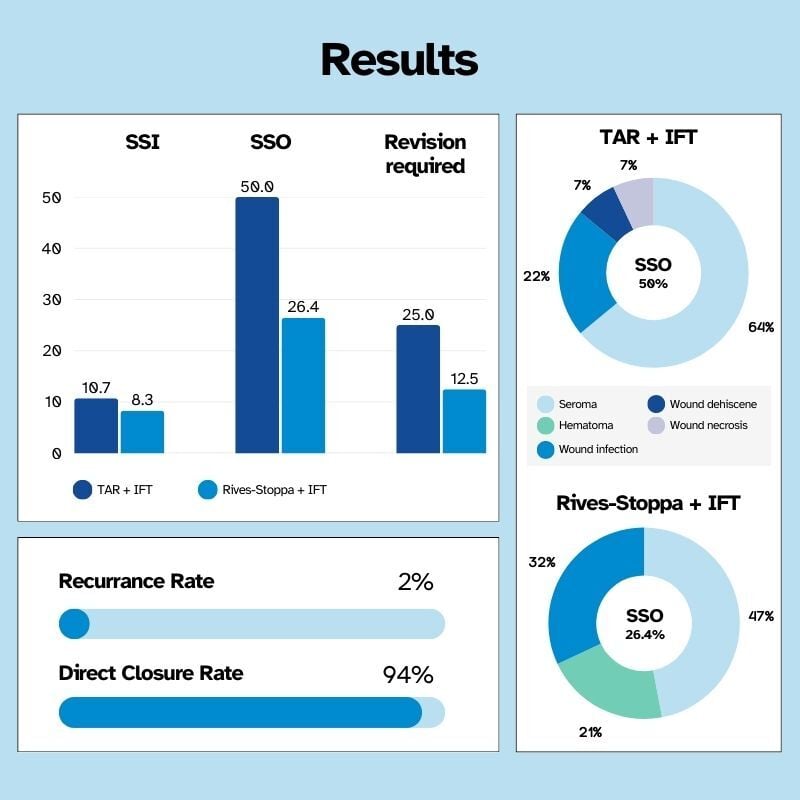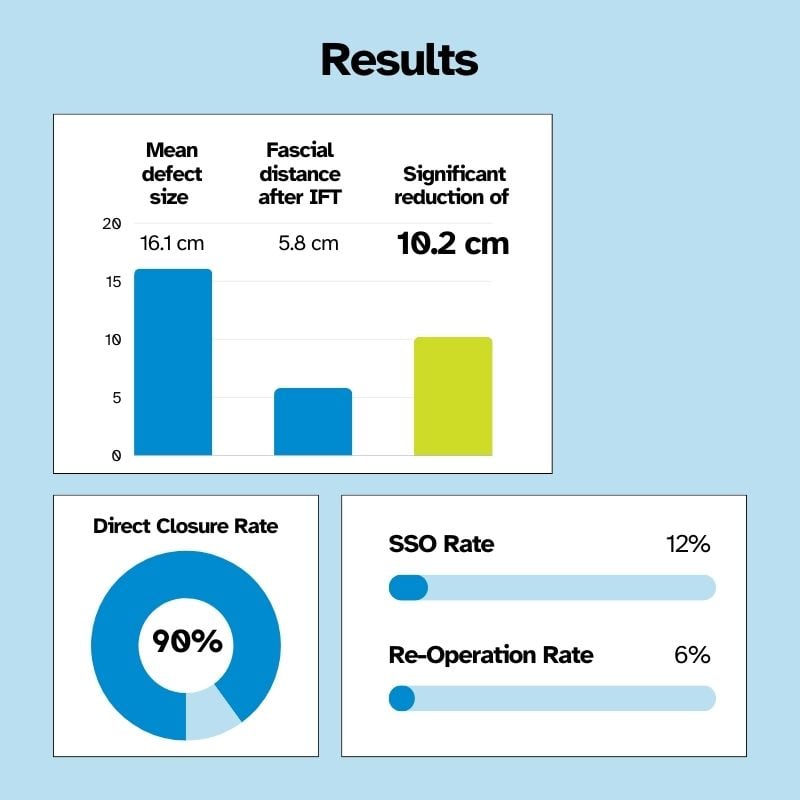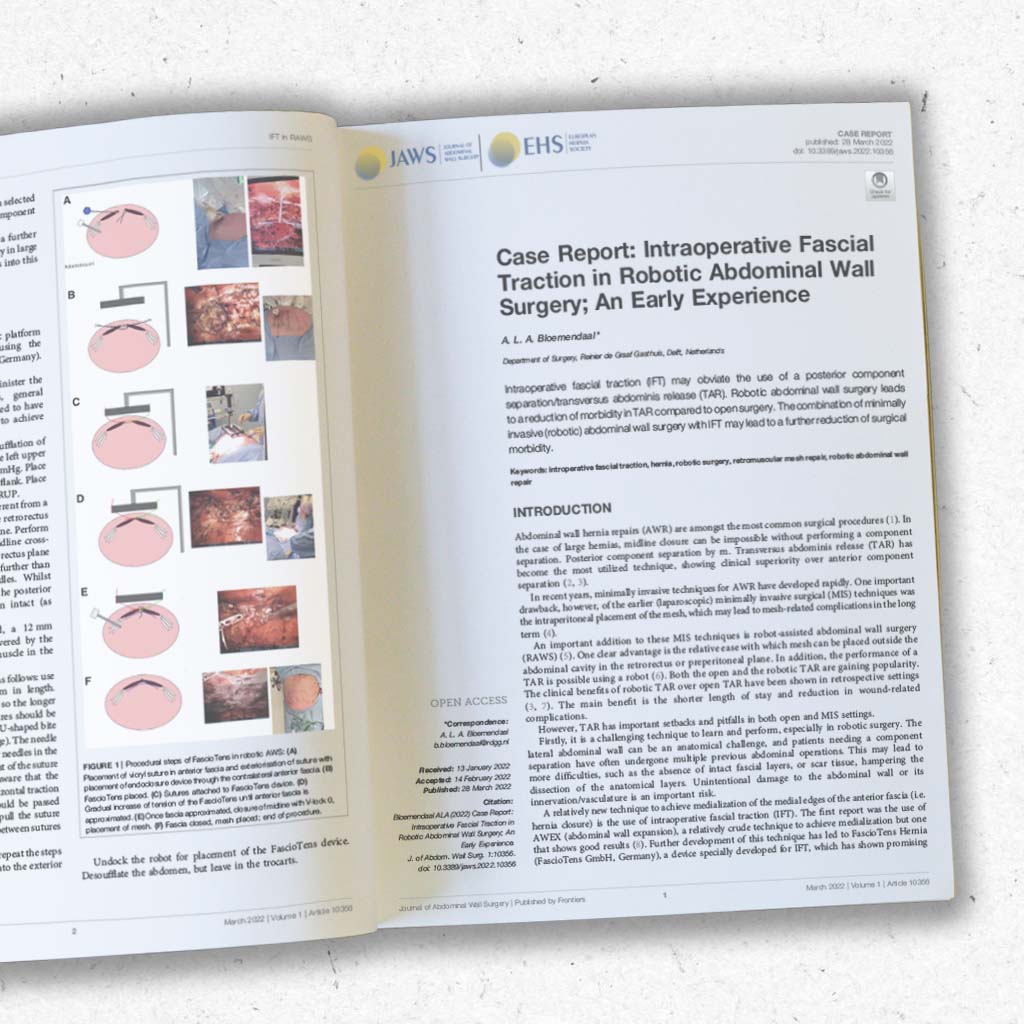Clinical use and scientific data of fasciotens®Hernia
Our case reports give you valuable insights: Explore how fasciotens® is used in ORs worldwide in clinical routines.
To read more about the scientific aspects head to the publications.
Case Reports
Get detailed insights in the OR and see how the system works in real cases
Publications & clinical data

Springer Hernia, 29:154 (2025)
Follow-up of Complex Hernia Repair with Intraoperative Fascial Traction
This is the first publication to report long-term follow-up data on intraoperative fascial traction in complex hernia repair. The study includes data from 100 patients compelling 30-days postoperative outcomes and follow-up data gathered after outpatient appointments, including standardised dynamic abdominal wall ultrasound (DAWUS). The defect width in this cohort was 15.8 cm on average. 87 % of all patients were pre-treated with Botulinum Toxin A.
- Low recurrence rate of 2%
- Mean follow-up time of 19.6 months
- Direct closure rate of 94%
- Significantly higher complication rate if additional TAR was performed

Springer Hernia, 28:2273–2283 (2024)
Preoperative botulinum toxin A (BTA) and intraoperative fascial traction (IFT) in the management of complex abdominal wall hernias
The study provides an overview of using IFT and BTA in complex hernia surgery and assesses short-term outcomes (after 30 days). Cases were included if BTA and Rives-Stoppa alone didn't lead to a reconstruction of the abdominal wall. Intraoperative reduction of transverse hernia diameter of 9.81 cm (mean) is in line with findings from previous studies. The Hamburg algorithm was developed based on the results.
- Closure rate of 95.6% in cases up to 15 cm width
- Mean operative time of 183.6 min including 30 min of IFT (less than comparable data for TAR)
- TAR rate increases with hernia diameter
- Complication and re-operation rates are significantly higher if additional TAR was performed

Chirurg 93, 292–298 (2022)
Intraoperative fascial traction (IFT) for the treatment of large ventral hernias
This study summarises a retrospective analysis of 50 cases treated with IFT. 94 % of the patients had a hernia width above 10 cm (W3 according to EHS). Mean defect size before traction was measured at 16.1 cm intraoperatively.
- 90% successful closure
- Low complication rate: 12% postoperative complications whereof 50% didn't need surgical intervention
- all patients received augmentation in sublay position
- No cases of abdominal compartment syndrome

Journal of Abdominal Wall Surgery, 1:10356 (2022)
Intraoperative Fascial Traction in Robotic Abdominal Wall Surgery; An Early Experience
The first article reporting of 3 cases combining robotic ventral hernia repair and intraoperative fascial traction. A retromusculular hernia repair was performed followed by a transcutaneous IFT.
- First cases showed promising results
- IFT is easily combinable with robotic hernia repair
- IFT facilitates robotic suturing of the hernia defect
- IFT can potentially be used in robotic repair for very large defects
More publications about fasciotens®Hernia
S. Groß, 2025
Osterix im Land der Hernien
H. Gök, 2025
Case Report: Intraoperative Fascial Traction for Increasing Intra-Abdominal Volume in Loss-of-Domain Incisional Hernias: A Report of Two Cases
Niebuhr et. al., 2024
Assessment of myofascial medialization following intraoperative fascial traction (IFT) in a cadaveric model
D. Eucker, R. Rosenberg, 2023
„Loss of domain“ und Verringerung der medianen Nahtspannung
J. Gorjanc et. al.,2023
The use of intraoperative fascial traction in W3-incisional hernia repair: A revolution or an emergency exit (two case reports)
B. Romain, G. Sauvineta, T. Rebierea, 2022
A complex incisional hernia repair with Intraoperative Fascial Traction device (with video)
H. Niebuhr et. al., 2021
Intraoperative Fascia Tension as an Alternative to Component Separation. A Prospective Observational Study







%20-%20Open%20Approach%2015cm_photo8.jpg?width=770&name=Mahadar%20(Mumbai)%20-%20Open%20Approach%2015cm_photo8.jpg)

